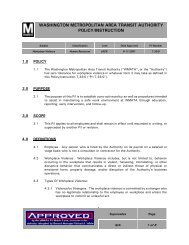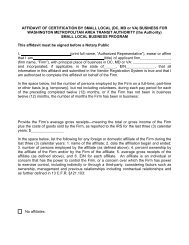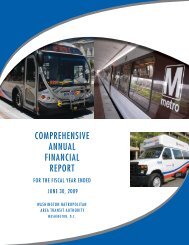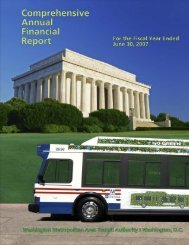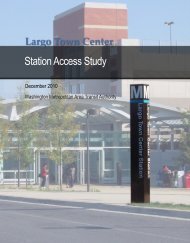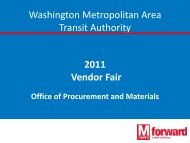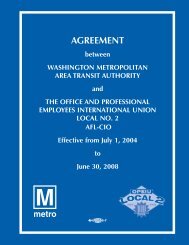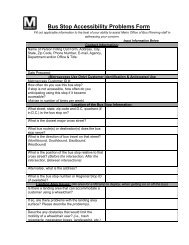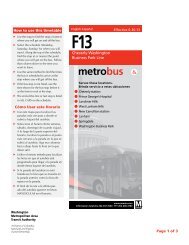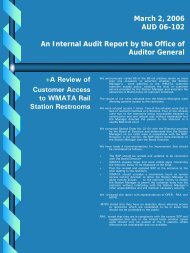Naylor Road Metro Station Area Access and Capacity - WMATA.com.
Naylor Road Metro Station Area Access and Capacity - WMATA.com.
Naylor Road Metro Station Area Access and Capacity - WMATA.com.
Create successful ePaper yourself
Turn your PDF publications into a flip-book with our unique Google optimized e-Paper software.
Nearby Branch Avenue bus stops<br />
lack amenities <strong>and</strong> this study<br />
re<strong>com</strong>mends adding amenities<br />
to enhance the convenience <strong>and</strong><br />
accessibility for bus passengers.<br />
Additional amenities outside of<br />
the study area but within 1/2-mile<br />
of the station are needed at stops<br />
Table 26: Bus Re<strong>com</strong>mendations<br />
Location Re<strong>com</strong>mendation<br />
Bus Bays Require bus drivers to leave Bay C after discharging passengers<br />
Require operators of large shuttles to apply for a station access permit*<br />
General Add bus stop amenities—benches, shelters, sidewalk connections, <strong>and</strong><br />
ADA accessibility features—where missing<br />
* Requires adherence to <strong>Metro</strong>’s shuttle bus policy, two key factors are sufficient bus bay capacity<br />
<strong>and</strong> <strong>com</strong>pliance with insurance requirements.<br />
along Curtis Drive, 28th Parkway, <strong>and</strong> Berkley Street. Many of these stops lack amenities<br />
suggested for basic bus stops, most notably amenities such as sidewalks or ADA-<strong>com</strong>pliant<br />
curb ramps. Adding these <strong>and</strong> other basic amenities, for example schedules, concrete<br />
boarding pads, <strong>and</strong> NextBus information signs, would improve the bus riding experience for<br />
existing passengers <strong>and</strong> possibly attract additional riders. Improving these stops will require<br />
coordination between <strong>Metro</strong> <strong>and</strong> Prince George’s County DPW&T.<br />
Some improvements can be made in the station area, too. <strong>Metro</strong> should require bus drivers to<br />
exit the Bay C drop-off area immediately after discharging all passengers <strong>and</strong> relocate their bus<br />
to either their assigned bay or the layover area, depending on the next scheduled departure<br />
time. Supervisors should enforce this <strong>and</strong> all other st<strong>and</strong>ard <strong>Metro</strong> operating rules to reduce<br />
operational conflicts at this occasionally congested location.<br />
Finally, though no private or public shuttle operators serve <strong>Naylor</strong> <strong>Road</strong> <strong>Station</strong>, this study<br />
estimates some shuttle activity in the future, most likely once redevelopment is <strong>com</strong>plete. <strong>Metro</strong><br />
should require shuttle operators in the future to apply for use of station bus bays for large<br />
shuttle buses. Issuance of permits is dependent on several factors including bus bay capacity <strong>and</strong><br />
providers <strong>com</strong>pliance with insurance requirements. More details on <strong>Metro</strong>’s proposed shuttle<br />
permitting program can be found in the Shuttle Services at <strong>Metro</strong> Facilities plan.<br />
Bus delay at <strong>Naylor</strong> <strong>Road</strong> roundabouts <strong>and</strong> <strong>com</strong>bined Kiss & Ride/bus bay access points are<br />
notable deficiencies, but improvements to these issues should be addressed during development<br />
of the final TOD site plan of the station area. Designers should look for opportunities to separate<br />
the entrances to these facilities <strong>and</strong> route buses away from unsignalized intersections with heavy<br />
traffic volumes, such as the <strong>Naylor</strong> <strong>Road</strong> roundabouts.<br />
Kiss & Ride<br />
The Kiss & Ride facility as currently configured is large enough to ac<strong>com</strong>modate existing <strong>and</strong><br />
future dem<strong>and</strong>. However, some signage <strong>and</strong> striping modifications to the existing Kiss & Ride<br />
could improve operations during congested periods. This study assumes that more substantive<br />
design changes will likely occur in the future to ac<strong>com</strong>modate station area redevelopment.<br />
Re<strong>com</strong>mendations for Kiss & Ride operations are highlighted in Table 27.<br />
In advance of station<br />
redevelopment, alteration<br />
of the Branch Avenue<br />
station entrance should<br />
be considered to remove<br />
Table 27: Kiss & Ride Re<strong>com</strong>mendations<br />
Location Re<strong>com</strong>mendation<br />
Kiss & Ride Improve motorist awareness of Kiss & Ride entrance at Branch Avenue<br />
Add striping <strong>and</strong> signage to encourage motorists to queue near Kiss & Ride shelters<br />
Designate space for small shuttles<br />
57 | <strong>Station</strong> Re<strong>com</strong>mendations





